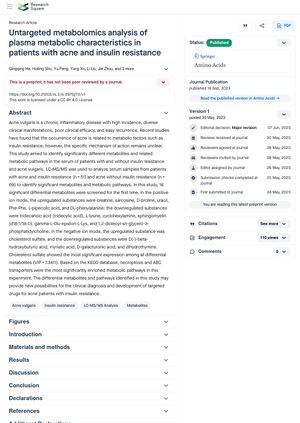Untargeted Metabolomics Analysis of Plasma Metabolic Characteristics in Patients With Acne and Insulin Resistance
May 2023
in “
Research Square (Research Square)
”
acne insulin resistance creatine sarcosine D-proline uracil Phe-Phe L-pipecolic acid DL-phenylalanine cholesterol sulfate tridecanoic acid L-lysine cyclohexylamine sphingomyelin gamma-L-Glu-epsilon-L-Lys 1,2-dioleoyl-sn-glycero-3-phosphatidylcholine D(-)-beta-hydroxybutyric acid myristic acid D-galacturonic acid dihydrothymine necroptosis ABC transporters

TLDR Patients with acne and insulin resistance have different blood metabolites compared to those with only acne, which could help in diagnosis and treatment.
The study aimed to identify different metabolites and metabolic pathways in the serum of patients with acne and insulin resistance (51 patients) versus those with acne but without insulin resistance (69 patients). Using LC-MS/MS analysis, 18 significant differential metabolites were identified. Upregulated substances included creatine, sarcosine, D-proline, uracil, Phe-Phe, L-pipecolic acid, DL-phenylalanine, and cholesterol sulfate. Downregulated substances included tridecanoic acid, L-lysine, cyclohexylamine, sphingomyelin, gamma-L-Glu-epsilon-L-Lys, 1,2-dioleoyl-sn-glycero-3-phosphatidylcholine, D(-)-beta-hydroxybutyric acid, myristic acid, D-galacturonic acid, and dihydrothymine. Cholesterol sulfate showed the most significant expression among all differential metabolites. Necroptosis and ABC transporters were the most significantly enriched metabolic pathways. These findings may offer new possibilities for the clinical diagnosis and development of targeted drugs for acne patients with insulin resistance.








